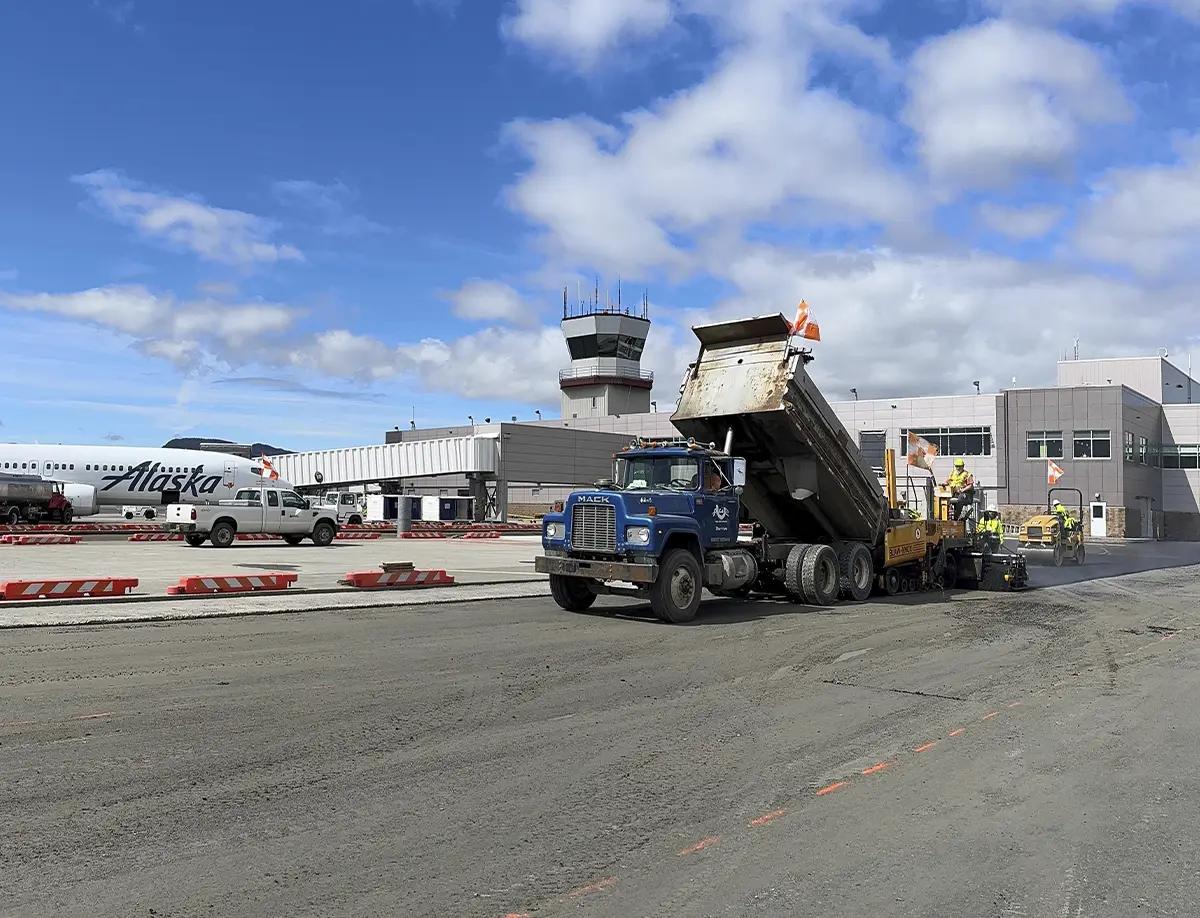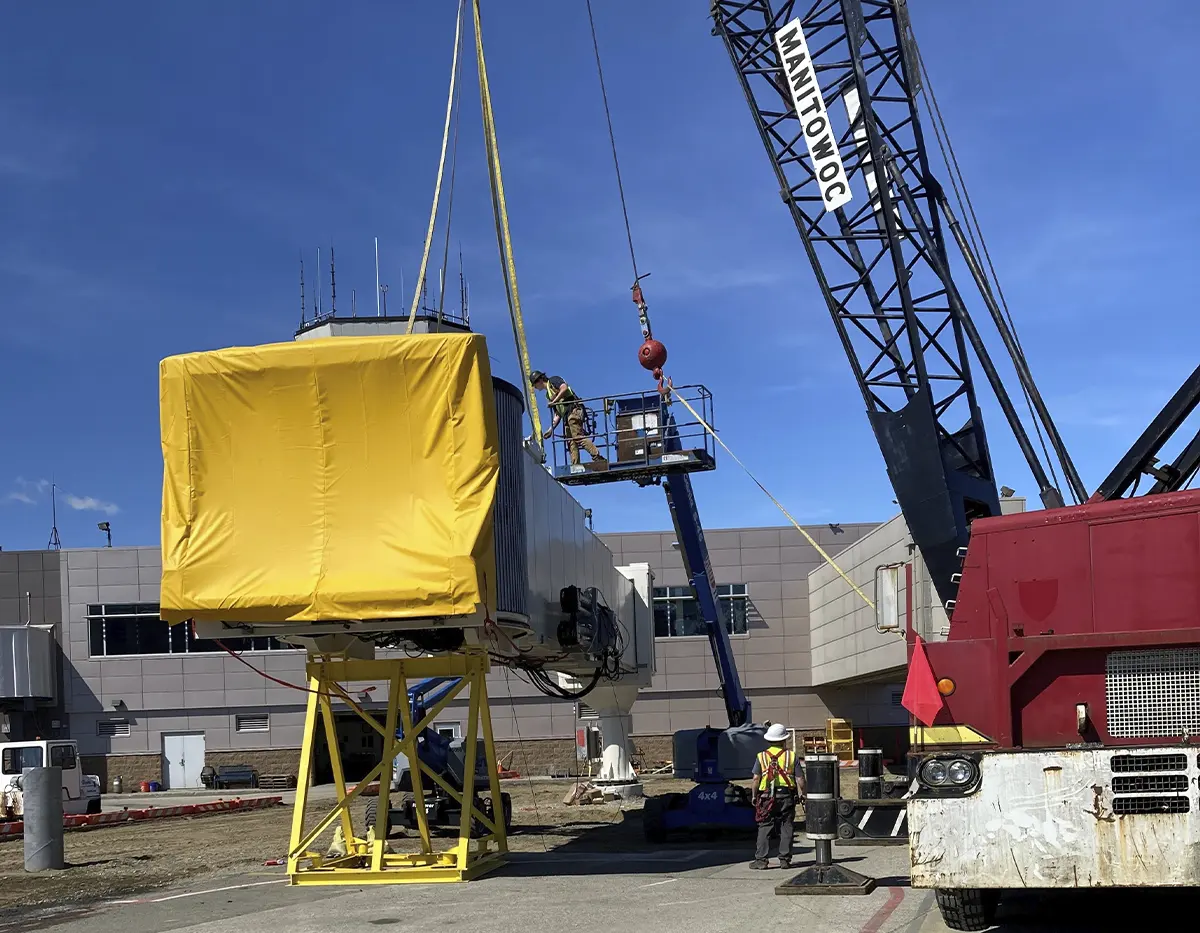
t’s not often that a construction project gets completed one-and-a half years ahead of schedule, but according to SECON Project Engineer Jared Mackey, the collaboration between everyone involved in recent Juneau Airport improvements allowed them to finish in May, instead of on the projected completion date of September 2026.
“It’s not just one party that deserves praise for getting this project completed in a timely manner,” he says. “The City and Borough of Juneau’s ability to work with the airport’s tenants and contractors, and DOWL Engineers’ ability to deal with constant planning and rephasing was a big help, as was the commitment of SECON and the project’s subcontractors to working long, hard hours to complete a year and a half ahead of schedule.”
The $14.7 million project included rehabilitating the Part 121/135 apron and remaining overnight, or RON, parking apron, which were both more than thirty years old.
“The timing of the project followed the Alaska Department of Transportation’s asphalt pavement and classification, which identified the apron surfaces as needing replacement, and the apron work and RON work were combined into a single project for efficiency,” explains Juneau Airport Project Manager Mike Greene.
During the design phase of the project, the airport intentionally created a lineal schedule, identifying each of the twelve project work phases, and assigning a work period for each.
“As we had hoped, SECON elected to address the work by overlapping work phases, which allowed them to work in more than one phase area at a time, effectively shaving an entire year off of the schedule,” says Greene.

“These aprons/ramps abut one another and cover an area of approximately 23 acres. The last major rehabilitation occurred more than twenty years ago, with more recent repairs occurring in areas around the jet bridges,” says Greene. “The pavement on both aprons/ramps had been determined to be well beyond its useful life and had been showing signs of deterioration from heavy aircraft use.”
While crack sealing and temporary repairs had been done over the years as a stopgap measure, they could no longer address all areas of failing pavement, including potholes, spalling, ponding in low spots, and drainage/catch basin fatigue.
The project also addressed the existing apron lighting mounted on the south side of the terminal that created cockpit glare and cast shadows from parked aircraft that prevented the illumination of work areas around the aircraft.
“This project introduced new lighting away from the terminal near the ends of the jet bridges that will cast light directly downward to fully illuminate the areas used by ground crews,” says Greene.
“In the past, every night from late-May to mid-September, gate parking was at capacity,” says Greene, noting that air carriers often used the freighter parking across the ramp as a RON spot between freighter arrivals.
“Air carriers also towed their 737 RON aircraft to the north ramp, though the pavement was not suitable for that type of aircraft,” adds Greene. “Additionally, small aircraft parked on the outside parking spots on the 135 ramp were displaced at night to allow the 737 [aircraft] sufficient space to be towed to/from the area until a gate became available.”
Work on the RON included construction of subsurface structural subbase and base course, the installation of a reinforced concrete hardstand, the placement of asphalt paving to meet weight standards for large, scheduled passenger aircraft parking, and striping and marking associated with parking and lead-ins.
“The worn and damaged asphalt surfaces have now been replaced, which directly benefits every aircraft that traverses these aprons, as well as improves the efficiency of snow removal operations,” says Greene. “Juneau now has a dedicated hardstand for use by any aircraft that needs to overnight (without tying up a passenger boarding bridge/gate) and provides a parking position for any aircraft experiencing a mechanical [issue].”
SECON coordinated its construction work with other airport projects: JIA’s replacement of the passenger boarding bridge at Gate 5, as well as Alaska Airlines’ replacement of passenger boarding bridges at Gate 3 and Gate 4, and expansion of Alaska Airlines’ air-cargo hardstand.

“There were numerous airport stakeholders affected by our work, including Alaska Seaplanes, Ward Air, Coastal Helicopters, Alaska Airlines, and Delta, so it took constant communication and planning to find a way to keep everyone happy,” says Mackey. “We also live in a rainforest, so we had to take advantage of non-rain days, working 14- to 18-hour days and weekends.”
SECON also took long lead times into account and started procuring the items it would need in 2023. To make sure they had enough workers, and to complete the airport improvements on time, the contractor juggled other projects.
“We have labor shortages here like they have everywhere else because the workforce is getting smaller,” says Mackey. “We only have so many union employees, and have a number of projects going on at the same time, including in Haines and Ketchikan, so we had to share our workforce. Sometimes that meant flying in certain people for different aspects of work and flying them out again when it was done.”
The full project included thirty SECON employees as well as roughly sixty subcontractor employees. Associated General Contractors, or AGC, of Alaska member companies who worked as subcontractors on the project include Compass Construction, LLC; DOWL; and Pacific Asphalt, LLC.